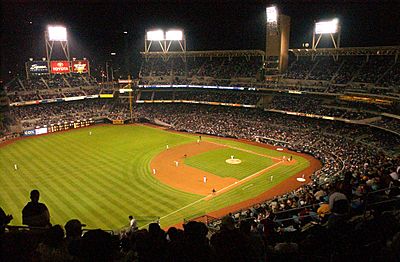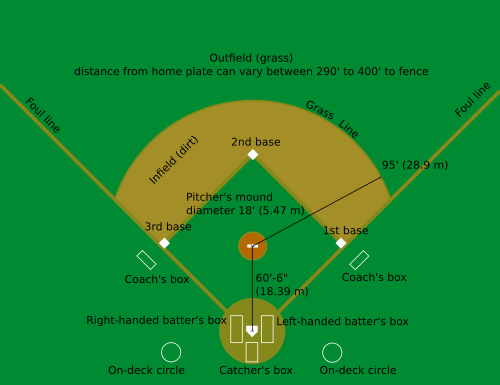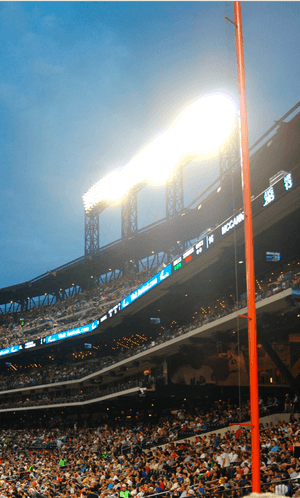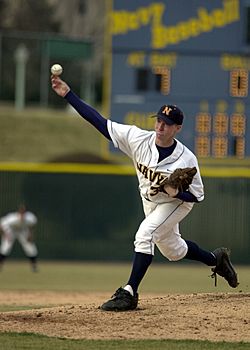Baseball field facts for kids
A baseball field or baseball diamond is the field upon which the game of baseball is played.
Contents
Specifications
The starting point for much of the action on the field is home plate, which is an irregular white rubber pentagon 17 inches by 8 1/2 by 12 by 12 by 8 1/2 inches (defined in the rule book as a one-foot square with "two of the corners filled in"). Next to each of the two parallel 8 1/2 inch sides is a batter's box. The point of home plate where the two 12 inch sides meet at right angles, is at one corner of a ninety-foot square. The other three corners of the square, in counterclockwise order from home plate, are called first base, second base, and third base. Three canvas bags fifteen inches (38 cm) square mark the three bases. These three bags along with home plate form the four bases at the corners of the infield.
A subtlety about the bases is that home plate and the first and third base bags are entirely within the ninety-foot square. They are positioned this way to help the umpires, as any ball hitting those bases must necessarily be in fair territory. Home plate has its peculiar shape in order to help the plate umpire judge whether a pitch is over the plate or not, i.e. whether it might be in the strike zone. The second base bag, which is fully within fair territory, is placed so that its center coincides exactly with the corner or "point" of the ninety-foot infield square. Thus, although the "points" of the bases are 90 feet apart, the physical distance between each successive pair of base markers is closer to 88 feet.
The lines from home plate to first and third bases are extended to the nearest fence, stand or other obstruction and are called the foul lines. The portion of the playing field between (and including) the foul lines is fair territory; the rest is foul territory. The area in the vicinity of the square formed by the bases is called the infield; fair territory outside the infield is the outfield. Most baseball fields are enclosed with a fence that marks the outer edge of the outfield. The fence is usually set at a distance ranging from 300 to 410 feet (90 to 125 m) from home plate. Most professional and college baseball fields have a right and left foul pole. These poles are at the intersection of the foul lines and the respective ends of the outfield fence. Another common feature of baseball fields is a warning track, a narrow dirt path that follows the outer edge of the outfield at the fence that serves to warn outfielders chasing a long fly ball of their proximity to the wall.
First base
First base is the first of four bases that must be touched by a player on the batting team in order to score a run. In contrast to second and third base, it is permitted for a runner to overrun first base without being in jeopardy of being put out after contact is made with the base, provided the runner makes no move to attempt to advance another base. A batter who accumulates four balls or is hit by a pitch is automatically permitted to take first base.
The first baseman is the defensive player responsible for the area near first base. Professional first basemen are often tall with long reaches in order to present a large target to which other fielders can throw. In the numbering system used to record defensive plays, the first baseman is assigned the number 3.
Second base
Second base, or 2B, is the second of four stations on a baseball diamond which must be touched in succession by a base runner in order to score a run for that player's team. Second base is typically defended by the second baseman and the shortstop. Second base is also known as the keystone sack. A runner on second base is said to be in "scoring position," owing to the high likelihood of reaching home plate and scoring a run from second base on most base hits. Since second is the farthest base from home plate, it is the most common target of base stealing.
The second baseman and shortstop ideally possess quick hands and feet and the ability to release the ball rapidly and with accuracy. One will usually cover second base when the other attempts to field the ball. Both players must communicate well to be able to make a double play. Particular agility is required of the second baseman in double play situations, which usually forces the player to throw towards first while his momentum carries him in the opposite direction. In the numbering system used to record defensive plays, the second baseman is assigned the number 4, and the shortstop 6.
Third base
Third base is the third of four bases a baserunner must touch in a counterclockwise succession in order to score a run. Many batted balls that result in the batter being put out (such as a sacrifice fly) may nevertheless allow a runner to reach home plate and score a run from third base, provided that the third and final out is not recorded before he can do so. A runner on third base is therefore particularly valuable to the batting team when fewer than 2 outs have been recorded.
The third baseman, abbreviated 3B, is the defensive player whose responsibility is to defend the area nearest to third base. A third baseman ideally possesses quick reaction to batted balls and a strong arm to make the long throw to first base. In the numbering system used to record defensive plays, the third baseman is assigned the number 5.
Home plate
In baseball and related games, home plate is the final base that a player must touch to score. Unlike the other bases, home plate is a pentagon and is hard, usually a slightly flexible hard plastic with beveled edges that rises only slightly above ground level.
50 to 100 feet (15 to 30 meters) behind home plate is the backstop, which is a wall/fence that will stop wild pitches, passed balls, and foul balls. In enclosed stadiums, the backstop is often comprised of a lower part, which is like any other part of the wall, and an upper netting to protect spectators seated behind it; in recreational baseball fields, there is usually a tall chain-link fence, including an angled top section, comprising the entire backstop.
The catcher, abbreviated C, is the defensive player who crouches behind home plate and receives balls thrown by the pitcher that are not struck by the batter. Additionally, the catcher covers home plate when a runner is attempting to score a run; he must tag the runner with the ball (or the glove with the ball inside) before the runner can touch home plate. Professional catchers in the major leagues often have large body frames to maximally obstruct home plate from the runner's access. In the numbering system used to record defensive plays, the catcher is assigned the number 2.
Foul poles
The purpose of the foul poles is to help the umpire judge whether a fly ball hit above the fence line is foul (out of play) or fair (a home run). The poles are a vertical extension of the foul lines. Both objects are used to determine whether a ball is foul or fair, but the names are misleading, because both the lines and the poles are actually within fair territory. Prior to 1920, the foul lines were "infinite": A fly ball over the fence had to land in fair territory, or to be fair "when last seen" by the umpire, in order to be a home run. The rule was changed to be where the ball is when it clears the fence. Thus, a fly ball hitting a foul pole above the top of the outfield fence is a home run, regardless of where the ball goes after striking this pole, and a fly ball clearing the fence on the fair side of the pole is a home run regardless of where it lands. Foul poles (shown above) are typically much higher than the top of the outfield fence, and often have a narrow screen running along the fair side of the pole to further aid the umpire's judgment. It can still be a difficult call, especially in ballparks with no outfield stands behind the poles to provide perspective. Wrigley Field is notorious for arguments over long, curving flies down a foul line (most notably in left field) which might even sail higher than the foul pole. Sometimes, even repeated TV replays cannot prove the call either way.
Pitcher's mound
In the middle of the square is a low artificial hill called the pitcher's mound. On the mound there is a white rubber slab, called the pitcher's plate or commonly the rubber, six inches (15 cm) front-to-back and two feet (61 cm) across, the front of which is exactly sixty feet six inches (18.4 m) from the rear point of home plate. This peculiar distance was set by the rulemakers in 1893, not due to a clerical or surveying error as popular myth has it, but purposely (as noted below). On a baseball field, the pitcher's mound is a raised section in the middle of the diamond where the pitcher stands when throwing the pitch.
In Major League Baseball, a regulation mound is 18 feet (5.5 m) in diameter, with the center 59 feet (18.0 m) from the rear point of home plate, on the line between home plate and second base. The front edge of the pitcher's plate or rubber is 18 inches (45.7 cm) behind the center of the mound, making the front edge's midpoint 60 feet 6 inches (18.4 m) from the rear point of home plate. Six inches (15.2 cm) in front of the pitcher's rubber the mound begins to slope downward. The top of the rubber is to be no higher than ten inches (25.4 cm) above home plate. From 1903 through 1968 this height limit was set at 15 inches, but was often slightly higher, sometimes as high as 20 inches (50.8 cm), especially for teams that emphasized pitching, such as the Los Angeles Dodgers, who were reputed to have the highest mound in the majors.
A pitcher will push off the rubber with his foot in order to gain velocity toward home plate when pitching. In addition, a higher mound generally favors the pitcher over a lower mound. With the height advantage, the pitcher gains more leverage and can put more downward velocity on the ball, making it more difficult for the batter to strike the ball squarely with the bat. The lowering of the mound in 1969 was intended to "increase the batting" once again, as pitching had become increasingly dominant, reaching its peak the prior year; 1968 is known among baseball historians as "The Year of the Pitcher". This restrictive rule apparently did its job, contributing to the hitting surge of modern baseball.
In Little League Baseball, the distance between the mound and homeplate is 46'. On "Pony" fields, homeplate is usually located about 54' away. This adjustment each graduation between leagues prepares the youngster for the maximum distance of 60 feet 6 inches in high school baseball.
A pitcher's mound is difficult for groundskeepers to maintain. On youth and amateur baseball fields, the mound may be much different from the rulebook definition due to erosion and repair attempts. Even in the major leagues, each mound gains its own character, as pitchers are allowed to kick away pieces of dirt in their way, thereby sculpting the mound a bit to their preference.
Baseline
A baseline is the direct route—a straight line— between two adjacent bases, though it is not drawn in chalk or paint on the field (though foul lines are drawn). The basepath is the region within three feet (0.9 meters) of the baseline. Baserunners are not required to run in this objective basepath, however; a baserunner may run wherever he wants when no play is being attempted on him. At the moment the defense begins to attempt a tag on him, his running baseline is established as a direct line from his current position to the base which he is trying for. The runner may not stray three feet away from this line in an attempt to avoid a tag; if he does, he is automatically out.
Grass line

The grass line, where the dirt of the infield ends and the grass of the outfield begins, has no special significance to the rules of the game, but it can influence the outcome of a game. Dirt running paths between the bases (and, at one time, between the pitcher and the catcher) have existed since the beginning of the game, although they were not mentioned in the rule books until around 1950, and their specifications are flexible. In addition to providing a running path, the grass lines act as a visual aid so that players, umpires and fans may better judge distance from the center of the diamond. Occasionally the ball may take a tricky bounce off the dirt area or the edge between the dirth and the grass. World Series championships (including 1924, 1960 and 1986) have been decided or heavily influenced by erratic hops of ground balls. In artificial turf stadiums (such as those with FieldTurf in Major League Baseball), infield dirt is placed only around the bases and around the pitcher's and batting areas; thus the "grass line" is designated with a white line. The exception is at St. Petersburg's Tropicana Field, where, in spite of artificial turf, standard dirt basepaths are used.
History
The basic layout of the diamond has been little changed since the original Knickerbocker Rules of the 1840s. The distance between bases was already established as 90 feet, which it remains to this day. Through trial and error, 90 feet had been settled upon as the optimal distance. 100 feet would have given too much advantage to the defense, and 80 feet too much to the offense. As athleticism has improved on both sides of the equation, 90 feet remains the appropriate balance between hitting and fielding, as it continues to provide frequent tests between the speed of a batter-runner and the throwing arm of a fielder.
It is the pitching distance, and other aspects of the pitcher's mound, and of pitching itself, that have been tinkered with from time to time over the many decades, in an effort to keep an appropriate balance between pitching and hitting.
In contrast to the distance between the bases, which seems natural enough, the very specific pitching distance of 60 feet 6 inches is one of those sports oddities that seems like a mistake unless one knows the history:
- The original Knickerbocker Rules did not specify the pitching distance explicitly.
- By the time major league baseball began in the 1870s, the pitcher was compelled to pitch from within a "box" whose front edge was 45 feet from the "point" of home plate. Although he had to release the ball before crossing the line, as with bowlers in cricket, he also had to start his delivery from within the box; he could not run in from the field as bowlers do. Furthermore, he had to throw underhand. By the 1880s, pitchers had mastered the underhand delivery quite well. The year 1880 saw two perfect games within a week of each other.
- In an attempt to "increase the batting", the front edge of the pitcher's box was moved back 5 feet in 1881, to 50 feet from home plate.
- The size of the box was tinkered with over the next few years. Pitchers were allowed to throw overhand starting in 1884, and that tilted the balance of power again. In 1887, the box was set at 4 feet wide and 5 1/2 feet deep, with the front edge still 50 feet from the plate. However, the pitcher was compelled to deliver the ball with his back foot at the 55 1/2 foot line of the box, thus somewhat restricting his ability to "power" the ball with his overhand delivery.
- In 1893, the box was replaced by the pitcher's plate, although the term "knocked out of the box" is still sometimes used when a pitcher is replaced for ineffectiveness. Exactly 5 feet was added to the point the pitcher had to toe, again "to increase the batting" (and hopefully to increase attendance, as fan interest had flagged somewhat), resulting in the peculiar pitching distance of 60 1/2 feet.
- Many sources tend to say that the pitching distance evolved from 45 to 50 to 60 1/2 feet. However, the first two were the "release point" and the third is the "pushoff point", so the 1893 increase was not quite as dramatic as is often implied; that is, the 1893 rule change added only 5 feet to the release point, not 10 1/2 feet.
- Originally the pitcher threw from flat ground (as softball pitchers still do), but over time the mound was developed, tipping the balance back the pitchers' way somewhat.
- The dirt path between the pitcher and the catcher was once as wide as the pitchers box and resembled the "pitch" area used in the game of cricket. Sometimes this path extended through the batting area and all the way to the backstop. Once the rounded pitcher's mound was developed, the path became more ornamental than practical, and was entirely abandoned by the late 1940s, although some recent teams (such as the Detroit Tigers) re-created the path in their new ballparks, for nostalgic reasons.
Images for kids
-
Kevin Pillar of the Toronto Blue Jays reaches first base safely as Chris Davis of the Baltimore Orioles attempts to scoop a bouncing ball thrown by one of the other infielders during a game in May 2017
-
Brian Dozier of the Minnesota Twins leaps over a sliding Jonathan Schoop of the Baltimore Orioles attempting to turn a double play
-
David Ortiz (in gray) of the Boston Red Sox stands in the left-handed hitters' batter's box at U.S. Cellular Field against the Chicago White Sox on July 7, 2006.
-
Kansas City Royals pitcher Gil Meche moves forward off the rubber as the pitch is released
-
Boston's Fenway Park's left-field wall, the Green Monster, in 2006, showing the manual scoreboard, and Green Monster seating, and the additions of charity advertisements along the top, billboards above the seating, and the American League East standings.
-
One of two foul poles at Citizens Bank Park, Philadelphia
See also
 In Spanish: Campo de béisbol para niños
In Spanish: Campo de béisbol para niños













